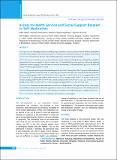Please use this identifier to cite or link to this item:
https://hdl.handle.net/20.500.14356/1307Full metadata record
| DC Field | Value | Language |
|---|---|---|
| dc.contributor.author | Mishra, Sudhir | - |
| dc.contributor.author | Suwannapong, Nawarat | - |
| dc.contributor.author | Tipayamongkholgul, Mathuros | - |
| dc.contributor.author | Aimyong, Natnaree | - |
| dc.date.accessioned | 2023-05-04T10:56:24Z | - |
| dc.date.available | 2023-05-04T10:56:24Z | - |
| dc.date.issued | 2020 | - |
| dc.identifier.citation | MishraS., SuwannapongN., TipayamongkholgulM., & AimyongN. (2020). Access to Health Service and Social Support Related to Self-Medication . Journal of Nepal Health Research Council, 18(3), 500-505. https://doi.org/10.33314/jnhrc.v18i3.2649 | en_US |
| dc.identifier.issn | Print ISSN: 1727-5482; Online ISSN: 1999-6217 | - |
| dc.identifier.uri | http://103.69.126.140:8080/handle/20.500.14356/1307 | - |
| dc.description | Original Article | en_US |
| dc.description.abstract | Abstract Background: In developing countries including Nepal, medicine is easy to purchase with or without prescription over the counter. People’s self-medication practice is a leading cause of antibiotic resistance. The purpose of this study was to assess self-medication practice and its influencing factors among rural people of Nepal. Methods: A cross-sectional survey was conducted from total 62 wards in rural Rolpa district of Nepal.The probability proportional to size was applied to select 6 wards, then 115 households from each ward was selected by applying systematic random sampling. Data collection was done by interviewing 720 household heads age 18 to 70 years old using a structured questionnaire in Nepal Results: The proportion of regular self-medication practice was 54.6%. Among them, 96.4% practiced self-medication when they got diarrhea/dysentery and 94.2% when they got a stomach ache. The factors associated with self-medication practice included gender (OR=2.24,95%CI=0.23-0.42), age (OR=5.59,95%CI=3.68-8.47), religion(OR=0.57,95%CI=0.42-0.77), family type (OR=4.00,95%CI=2.93-5.47), average income (OR=7.31,95%CI=5.04-10.56), decision making (OR=0.6,95%CI=0.44-0.82, health insurance(OR=1.64,95%CI=1.22-2.22), overall access to health service (OR=3.53,95%CI=2.55-4.90), and appraisal support(OR=2.24, 95%CI=1.66-3.02) Conclusions: Prevalence of self-medication in rural areas of Rolpa district was high among female, older people Accessibility to health service should be improved to reduce risk of self-medication practice. The health promotion related with benefit and side effect from self-medication are important for high risk group i.e. people over 30 years . Keywords: Access to health service; rural Nepal; self-medication; social support | en_US |
| dc.language.iso | en | en_US |
| dc.publisher | Nepal Health Research Council | en_US |
| dc.relation.ispartofseries | Jul-Sep 2020; | - |
| dc.subject | Access to health service | en_US |
| dc.subject | Rural Nepal | en_US |
| dc.subject | Self-medication | en_US |
| dc.subject | Social support | en_US |
| dc.title | Access to Health Service and Social Support Related to Self-Medication | en_US |
| dc.type | Journal Article | en_US |
| local.journal.category | Original Article | - |
| Appears in Collections: | Vol. 18 No. 3 (2020): Vol. 18 No. 3 Issue 48 Jul-Sep 2020 | |
Files in This Item:
| File | Description | Size | Format | |
|---|---|---|---|---|
| 2649-Manuscript-18849-1-10-20201115.pdf | Fulltext Article. | 186.71 kB | Adobe PDF |  View/Open |
Items in DSpace are protected by copyright, with all rights reserved, unless otherwise indicated.
